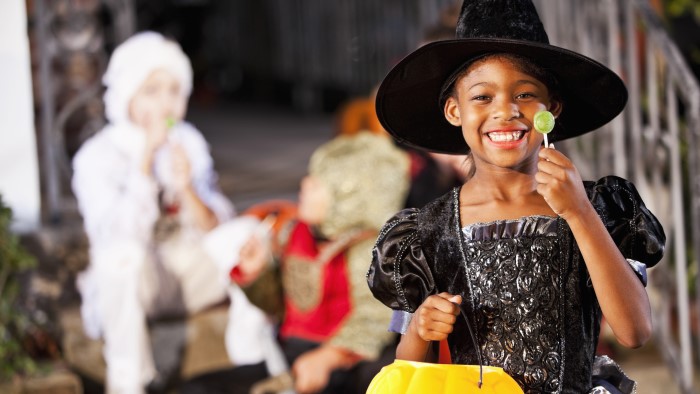


What scares you more? Ghosts or a mouthful of cavities at your child’s next appointment? When your child brings home a bag full of candy, it can be frustrating as a parent to know where to draw the line. How much should you let your child indulge in candy? And how much is too much?
As a pediatric dental practice, we’ve heard it all and are ready to help you set a good example for your child. Childhood is the perfect opportunity to help your son or daughter develop healthy eating habits that will last a lifetime.
Here’s how to get started and have a tooth-friendly Halloween.
With the pandemic, there may be restrictions on trick-or-treating in your area. But rest assured, there are still plenty of ways for your little ghoul or goblin to get their hands on a sweet sugar stash. Whether you buy candy from the store or your child brings home goodies from school, you’re bound to end up with a bucket full of candy by the end of the evening.
Our advice? Make sure your child eats a healthy, balanced dinner before the festivities begin. Your child will be much less likely to overeat Halloween candy if they’re trick-or-treating on a full stomach. Likewise, if you’re planning to stay in this year, hold off on sweets until the family is done eating dinner.
It’s easy to worry about Halloween candy. After all, you only want what’s best for your child and you don’t want to see them go through the pain of a toothache. But it’s also important to remember that Halloween is just one day out of the year.
If you’re feeding your child healthy foods year-round, eating Halloween candy isn’t going to derail everything that you’ve taught your child up to this point. Instead, it’s the perfect opportunity for your child to learn how to eat in moderation and listen to their body.
Children tend to be intuitive eaters and stop eating when they’re full. If they overindulge and get a stomachache, they’ll learn not to overdo it the next time around.
Don’t give candy more power than it deserves. The more neutral you act toward candy, the less power you give it. But restricting your child’s access to Halloween candy will have the opposite intended effect.
Acting like the “food police” doesn’t teach your child how to eat in moderation. Instead, it teaches your child to feel shame about eating “bad” foods. It also makes them crave foods that are in scarce supply or “forbidden.”
Here’s what we recommend. On Halloween night, let your child eat as much candy as they want. After all, Halloween only comes once a year. Then, the next day, you can introduce more structure to your child’s diet by limiting sweets to mealtimes. That way, your child isn’t snacking on candy 24/7.
If your child thinks you’re going to take away all their hard-earned candy as soon as they go to sleep on Halloween night, they’ll eat until they burst. But if they know that their candy will be waiting for them tomorrow, they’ll most likely eat a few pieces of candy that are their absolute favorites. They’ll then leave the rest for later. You may even find that your child won’t eat certain types of candy that they don’t like.
Your children watch you more than you think. This includes your eating habits. Set a good example for your child by eating Halloween treats in moderation. Practice mindfulness when you eat and stop before you feel sick or overly full. When you practice good eating habits, your children are more likely to follow suit.
This is not a Halloween-specific tip because your child should be brushing and flossing their teeth year-round. But sometimes it’s easy to slip up during the chaos of the holiday season. For example, trick-or-treating can disrupt your child’s normal bedtime routine.
Make sure your child continues to brush their teeth twice a day for at least two minutes at a time. They should also be flossing once a day to remove any plaque or food particles hiding between teeth.
If you have a young child, you should be brushing and flossing their teeth for them until they have the eye-hand coordination to tie their own shoes. This is typically around age six. But even then, you should continue to supervise your child to ensure they’re brushing and flossing properly.
To help you get started, check out our dental hygiene tips for toddlers. We also have a blog post on how to care for your baby’s first teeth.
Dr. Wanki William Kim is an experienced pediatric dentist in Grand Rapids, MI. He’s also accepting new patients and would be more than happy to welcome you and your child to our practice.
To request an appointment for your child, please call the Pediatric Dentistry of Michigan at (616) 447-7900. You may also fill out our online contact form and someone from our team will reach out to you soon.
Dental Services
Patient Resources